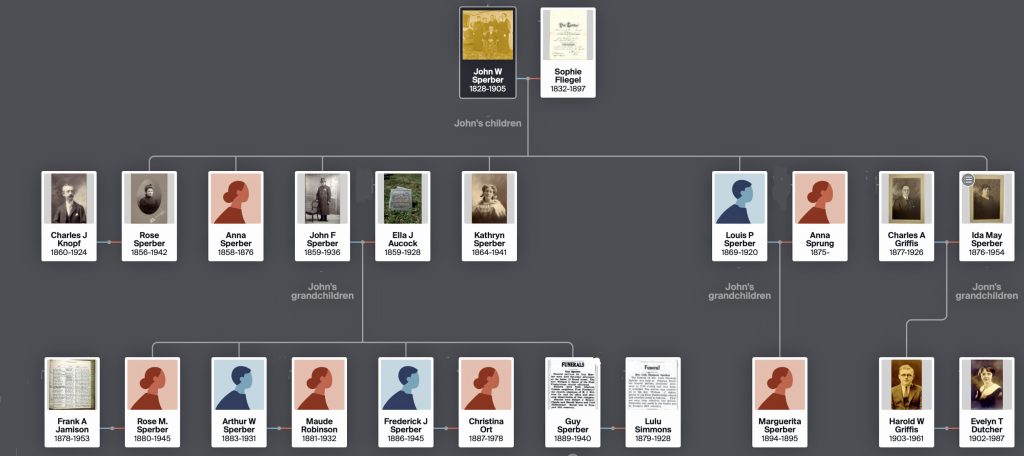One of the artifacts that my family has had in their possession is a one page document hand written in German. It is a document written in the late 1800’s. The document appears to contain brief statements with dates and names. The hand written document has been a mystery through time and generations within the family. It was assumed to have been a document written by one of the members of the Sperber family. The document was kept with a number of other documents in an envelope by John Wolfgang Sperber. I assumed that it was written by John Sperber.
The Handwritten Sperber Document

The one page document was kept with John Sperber’s marriage certificate and his naturalization papers. [1] As important as these two documents were to John Sperber, the one page hand written document was perhaps equally special but an enigma. Perhaps it was John Sperber’s handwriting.
John Wolfgang Sperber was the maternal grandfather of Harold William Griffis. John Sperber married Sophie Fliegel. They had six children: Rose, Anna, John Frederick, Kathryn, Louis, and Ida May. Ida, the youngest of the six children, was Harold’s mother.
The Family of John Wolfgang Sperber and Sophie Fliegel Sperber
Throughout the years that I had the document in my possession, I would periodically seek out someone who spoke or could read German and ask if they could translate the document. The typical response I got was, “It’s not modern German”, “I can’t decipher the handwriting”, or “The letters on some of the words are unintelligible”.
I had high hopes of success with giving a copy of the document to a dear friend who was Austrian. He basically came back with all three of the aforementioned typical responses.
The German Language and Writing German in the 1800’s
The German language has evolved over time and has many dialects. It is also a language that has been written in many styles. By the time the 16th century rolled around, there were numerous variants and standards in the German language. Slowly, they united. From the 16th to the 18th Century, the southern and central German dialects came together to form Neuhochdeutsch, otherwise known as New High German, the version of German that is spoken today with small modifications.
German was the language of commerce and government in the Habsburg Empire, which encompassed a large area of Central and Eastern Europe. Until the mid-19th century it was essentially the language of townspeople throughout most of the Empire. [2]
German Language in 1850 [3]
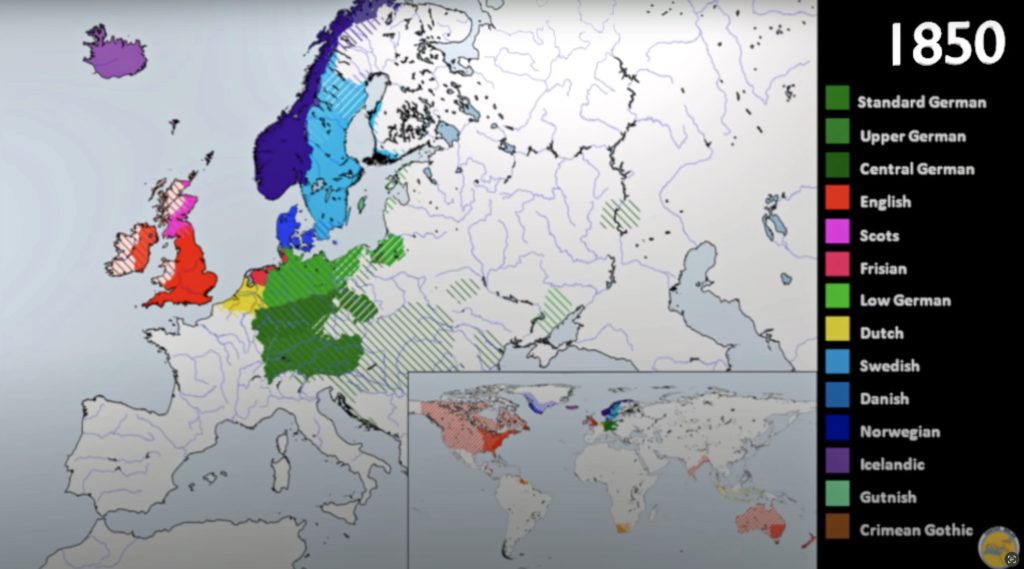
Until the early 20th century, German was printed in blackletter typefaces in Fraktur, and in Schwabacher; and was written in corresponding Kurrent and Sütterlin style handwriting. [3]
“Making sense of German historical documentation can be a challenge because the old German cursive alphabet kept changing. For those of you working on your family tree, reading the old German cursive alphabet is an exercise in frustration. Digging into genealogical records with aids to help you read them is almost impossible. Even if a person wrote Kurrent, individual writing styles, can make ledger entries frustrating to decipher.” [4]
Kurrent is an old form of German-language handwriting based on late medieval cursive writing, also known as Kurrentschrift (“cursive script”), deutsche Schrift (“German script”) and German cursive. Over the history of its use from the 15th into the first part of the 20th century, many individual letters acquired variant forms. The Kurrent alphabet is loaded with sharp angles and strange changes in direction. For example, there are three different “s’s”, depending on where the letter falls in the word. It is also confusing since the letters may look like completely different letters in modern writing. German writers used Kurrent cursive style as well as the Latin cursive style. [5]
Seeking Assistance on Facebook
I found a Facebook group, Germanic Genealology, Heritage, Language & Culture. [6] The group is a global support community focused on Germanic genealogy, heritage, language and culture and accepts members by request. I thought I would take a stab at posting the document on the group’s discussion thread to see if anyone could aid in translating the document.
I quickly received a comment from one of the group members. The individual proffered the results of a Google translation service that was generated by a software platform named Transkribus. [7] Transkribus helps you to convert old letters, documents and chronicles from old German scripts such as Kurrent, Sütterlin, Fraktur or Antiqua into readable text. Transkribus software uses artificial intelligence capabilities to translate documents.
While artificial intelligence is making notable advancements, the results of using on-line translation software, even for software that proclaims to be sensitive to historic contexts, are not perfect. As the support person indicates after providing the results of the translation, “there is much manual work to be done”. Translation, regardless of whether it is a mere letter or a literary piece, is an art form and requires the human touch. [8]
For privacy, I have not revealed names of those who assisted me in the translation. The following was the initial thread of discussion involved with producing a translation of he document.
Facebook Threaded Discussion on the Sperber Document – Part 1
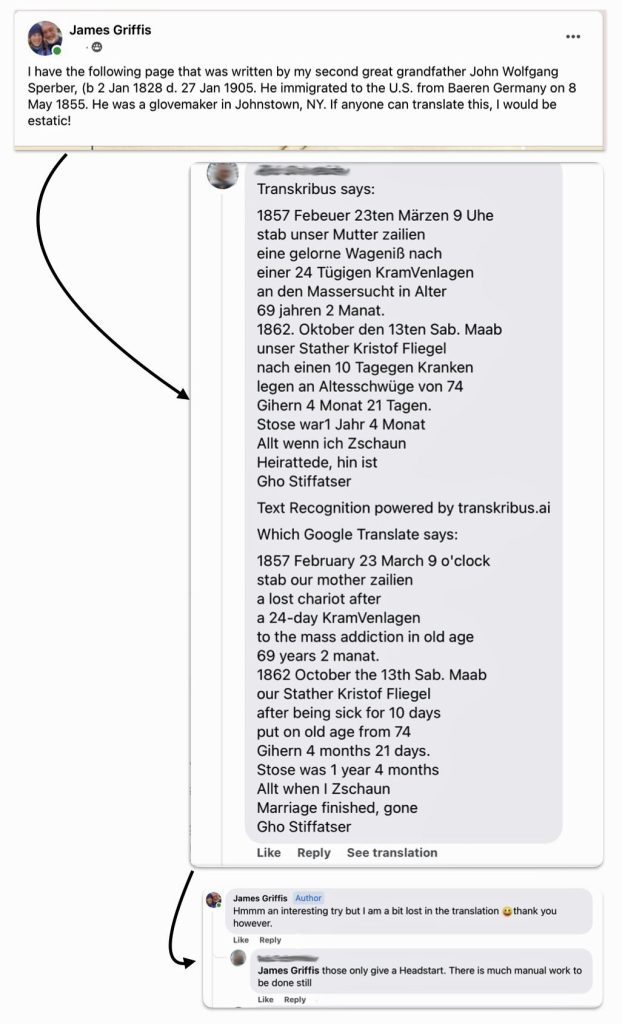
While I truly appreciated the assistance and the effort provided by the fellow discussion group member, I was hoping to receive additional ideas or personal attempts at a translation.
I perused the group’s discussion threads and came upon an individual who had translated a two page letter that was hand written in the 1800’s. I thought I would reach out to this individual to see if I could receive assistance.
Facebook Threaded Discussion on the Sperber Document – Part 2
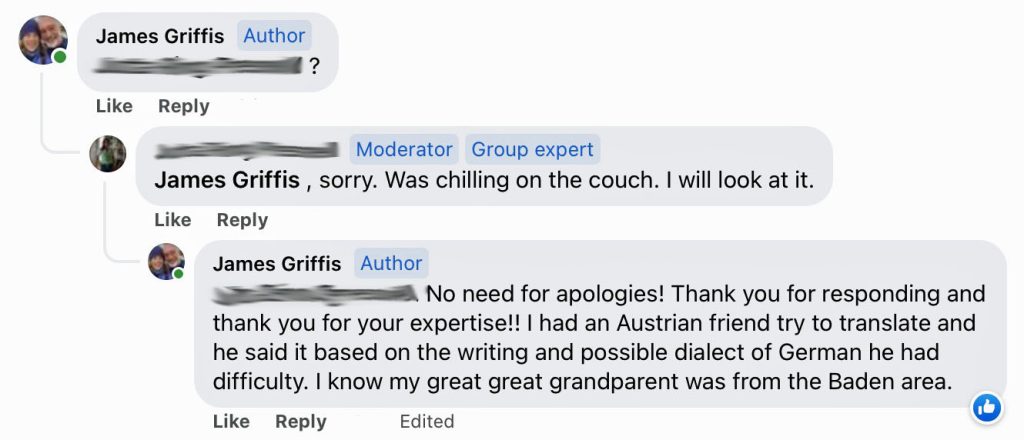
The reply was quick, within hours, and the person was so polite and apologized for not immediately responding! The individual proceeded to transcribe the handwriting on the one page document and then provide a translation, all within one response!
Facebook Threaded Discussion on the Sperber Document – Part 3
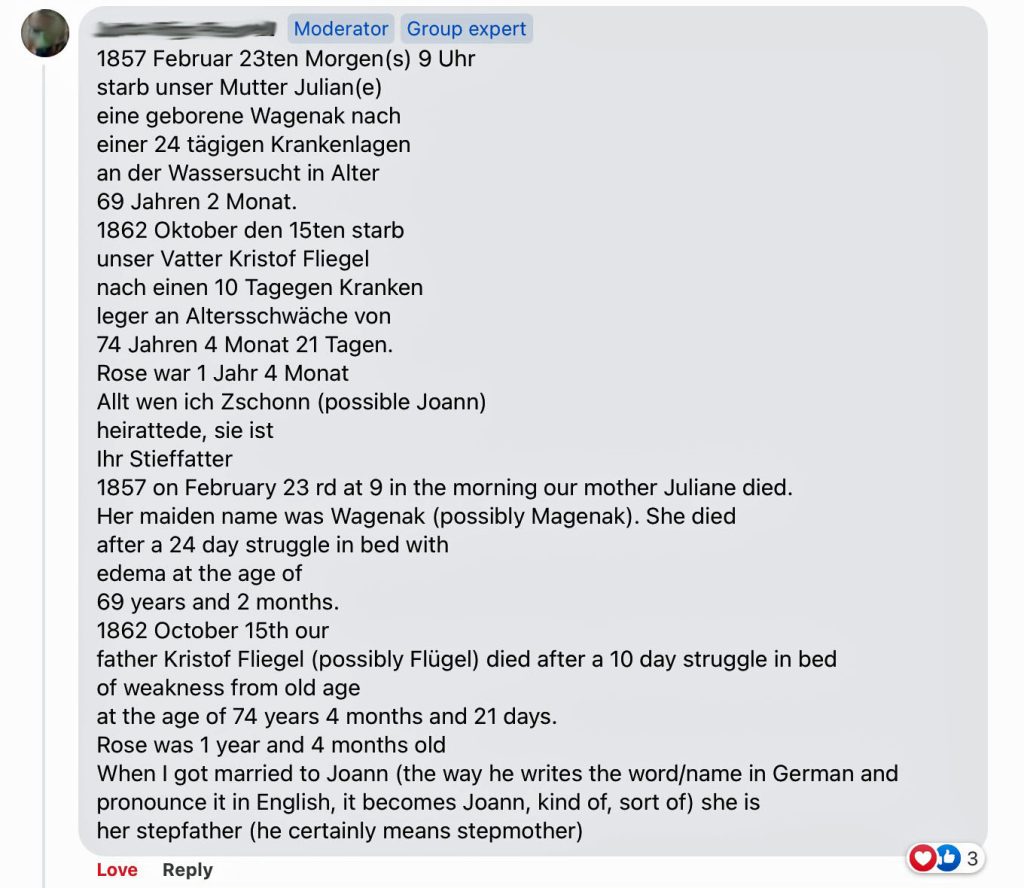
The ability to not only transcribe the hand writing but then provide a translation was amazing!
Since I assumed it was a document written by John Sperber, the individual who provided the translation assumed the individual was male and indicated that the last sentence was a bit puzzling. Perhaps the writer of the document used the wrong term “stepfather” and also references the “mother” as Joann.
Reading the first part of the translation lead me to believe the document was actually written by John Sperber’s wife, Sophie Fliegel. It made more sense that it was written by Sophie. “Our mother Julie” was certainly not referring to John’s literal mother. While John might have affectionately referred to his mother-in-law as ‘our mother’, it makes more sense that this was a letter written by Sophie Fliegel. The document also refers to “father Kristof Fliegel”.
Facebook Threaded Discussion on the Sperber Document – Part 4
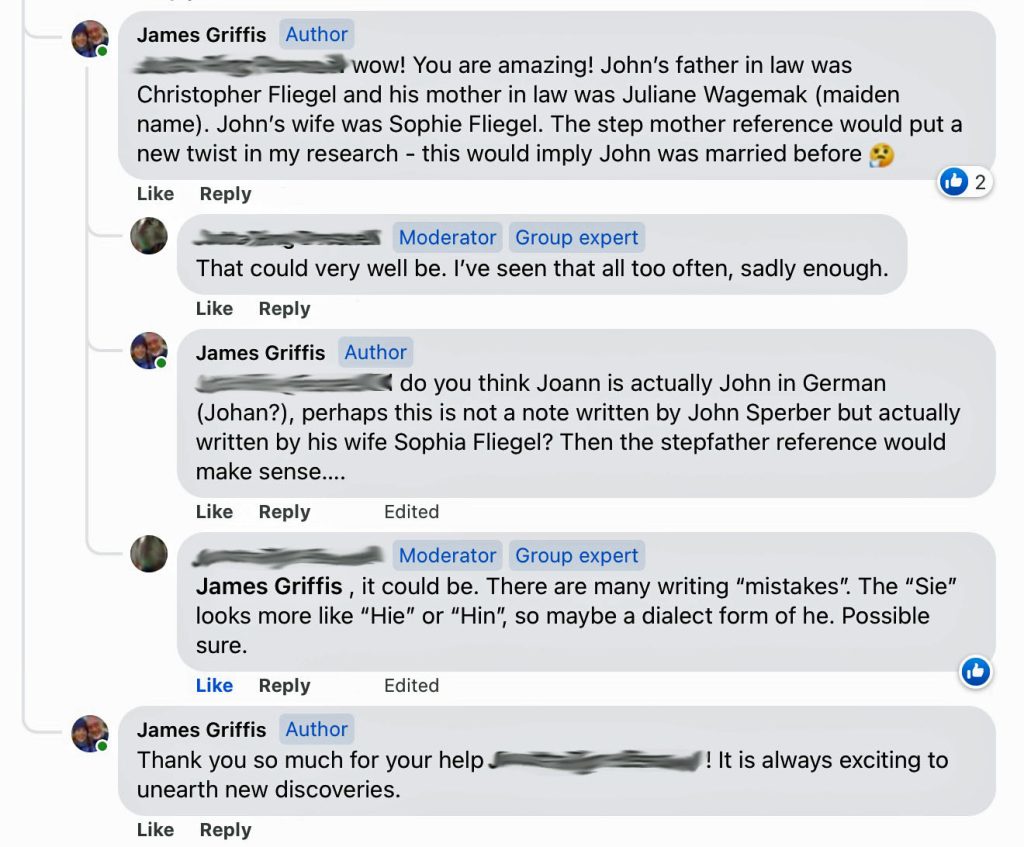
Hence, I believe the English translation of the ‘mystery document’ is as follows:

A Family Discovery Based on the Document
While the first two statements written by Sophie Fliegel Sperber, document the dates of death for her parents, the third statement found in this document raises a question of fact regarding the kinship structure of the Sperber family. The last sentence of this translated document raises a question regarding who is the father of Rose Sperber. The document indicates:
“Rose was 1 year and fourth months old when I got married to Johann he is her stepfather. ”
Looking at the following word ‘Johann’ in the document suggests it is a hand written variant of Johann, not Joann as the translation originally suggested:

Based on a reference cited by FamilySearch.org [9] you can type in a word in a German on-line form and it will produce a Kurrent script version of the word.
Example of Producing Kurrent Script for the Name Johann

The “o” is not apparent in the written version of Johann in the document but the “J” and “h” are similar in Kurrent script. It appears as if Sophie may have simply produced a downward stroke from the “J’ and then wrote an “H”. As the Facebook group translator indicated, “There are many writing mistakes” in the document.
“When people write in a hurry, details and clarity are often sacrificed. Hence, one misses distinctive features… . There are other features when hurried script is involved, such as merging letters…” [10]
It is apparent that Sophie Fliegel Sperber is referring to her husband, ‘Johann’ or ‘John’ Sperber as the stepfather of Rose.
Another Piece of Evidence
An old paper pamphlet that was used to record family births, deaths and marriages were part of the artifacts of Harold Griffis. The pamphlet originally was used to document the births, marriages and deaths of Sperber family members. It appears that the pamphlet in time came into the possession of Rose’s youngest sister, Ida Sperber. The names of Harold and Evelyn and their first three children were then added to the bottom of the list of the Sperber family. On another page, the birth dates, marriages and deaths of maternal relatives of Evelyn Griffis, The Platts family, were also added to the pamphlet. It became a living written family testament of vital statistics for the Sperber, Platts, and Griffis families.
Births of Sperber Family Members
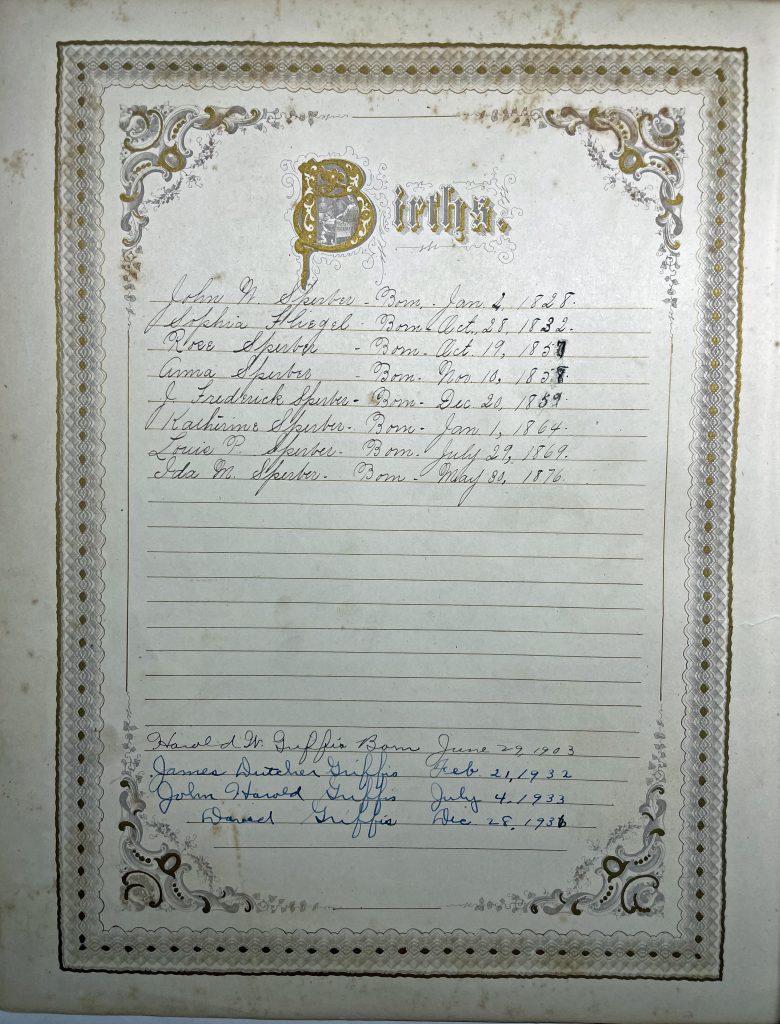
Rose Sperber is listed on the third line from the top of the page. A close examination of the brith years for Rose Sperber, her younger sister Anna and her brother J. Frederick indicate that their respective birth years have been altered on the paper. It appears that Rose’s brith year was changed to 1857. Anna’s birth year was initially changed to ‘1857’ and then to ‘1858’. Frederick’s birth year was changed to 1859. Based on how the revised numbers were written, it appears that the original author of the list made the changes. It is obvious an erasure was used to change the dates.
Close Up of the Birth Years
A closer look at the change of Rose’s birth year suggests that it was originally written as ‘1855’, which would have accurately reported her birth year as stated by Sophia Sperber on the one page document. The day of October 19th, fits the information found in the one sentence description of Rose’s birth and her relation to Johann Sperber.
It appears that whoever wrote the list of births did not want to correlate the birth dates with John and Sophia’s wedding date of February 2, 1857, which were found on another loose page of the same pamphlet. This would have suggested that Rose’s brith was before the date of the marriage between John and Sofia.
Dates of Marriage for Sperber Family Members

Rose Sperber: An Example of Premarital Sexual Practices in the 1800’s
One basic fact about the Sperber family that stands out is the birth date of the oldest child, Rose Sperber, and the date of marriage of John or Johann Sperber and Sophie Fliegel. I had assumed that Rose was born out of wedlock. It is important to use multiple records to learn if someone was born out of wedlock or ” illegitimate”.
“Using indirect and direct evidence will help conclude the legitimacy or illegitimacy of a person. Sometimes it is not plainly stated, but oftentimes analyzing each record and using them together will make one capable of making a conclusion.” [11]
Based on simple math, if Sophie and John were married Feb 2 1857 (see footnote [2]) and the one page document written by Sophie states that Rose was “one year and four months old” when Sophie and Johann were married, then Rose was born around October 1855 and was conceived around the beginning of 1855.
With the absence of birth records for Rose Sperber, based on various Federal and State Census tabulations, Rose Speber’s birth year has been identified as either 1855, 1856 or 1857. [12]
It appears that Rose Sperber was conceived around the time of Sophie’s arrival to the United States, at the beginning of 1855. [13] Sophie arrived in the United States from Germany with the family on January 26, 1855. There is no mention of an infant or a child under one year old on the ship manifest list. It is not evident that Sophie had a prior marriage. She still had her maiden name when she married John Sperber in 1857.
What was perhaps common knowledge in one generation is not necessarily passed down to the next generation or two. This makes sense. While out of wedlock births may have been commonplace and possibly accepted in various communities, it was and still can be a very sensitive topic and not one generally talked about openly.
In the Late Middle Ages, a third of the population was probably born extramaritally. From 1400 to 1600, the illegitimacy ratio dropped markedly, but from 1650 to 1850, it seems to have gradually risen from around five to nine percent in most European states. [14]
For the community, unmarried pregnancy was less a moral issue than a practical one of arranging support for the child. Most of the women in the colonial times and in the 1800’s married the father before the child was born, but for those who remained single, the process of establishing paternity was straightforward. The woman told the midwife the name of the father during delivery. If the situation lead to formal proceedings, the courts, on the assumption that a woman would not lie at such a time, then held the man responsible for the economic support of the child. [15]
Regardless of the sensitivity of out of wedlock births, Sophie and John lived within a time period where illegitimacy rates were high and in many communities out of wedlock children were accepted and treated equally. The reason for the increased illegitimacy rates in Europe and the United States are subject to academic debate but they nevertheless existed.

“The illegitimate fertility rate soared between 1750 and 1850, from one end of Europe to another.. In all but a handful of villages and cities for which data are available, illegitimacy rose, departing from modest plateaus of one to three percent of all baptisms, to often ten or fifteen per cent. Also prebridal pregnancy, women who are already pregnant when they marry, climbed dramatically. The percentage of first children born less than eight months after marriage in parish register data also rose along with illegitimacy in most places.” [16]
It is not known who Rose’s biological father is. It is assumed that Sophie lived with her daughter in her father’s home. Within a year, she met and had a short courtship with John, they fell in love, they were married and started their family. Rose was accepted as John’s own daughter.
The One Page Document
Before Sophie passed away in 1897, she wrote this undated short note composed of three events that were important to her. John kept this note along with his marriage certificate and naturalization paper. It was an important document to him and perhaps was significant in many ways.
Sources
Feature image: Alphabet in Kurrent script from about 1865. The next-to-last line shows the umlauts ä, ö, ü, and the corresponding capital letters Ae, Oe, and Ue; and the last line shows the ligatures ch, ck, th, sch, sz (ß), and st. Kurrent (German: [kʊˈʁɛnt]) is an old form of German-language handwriting based on late medieval cursive writing, also known as Kurrentschrift (“cursive script”), deutsche Schrift (“German script”) and German cursive. Over the history of its use into the first part of the 20th century, many individual letters acquired variant forms.Source: Kurrent, Wikipedia,This page was last edited on 5 January 2023 https://en.wikipedia.org/wiki/Kurrent
[1] The other two documents kept with the one page handwritten document were John Sperber’s marriage certificate and his naturalization paper:
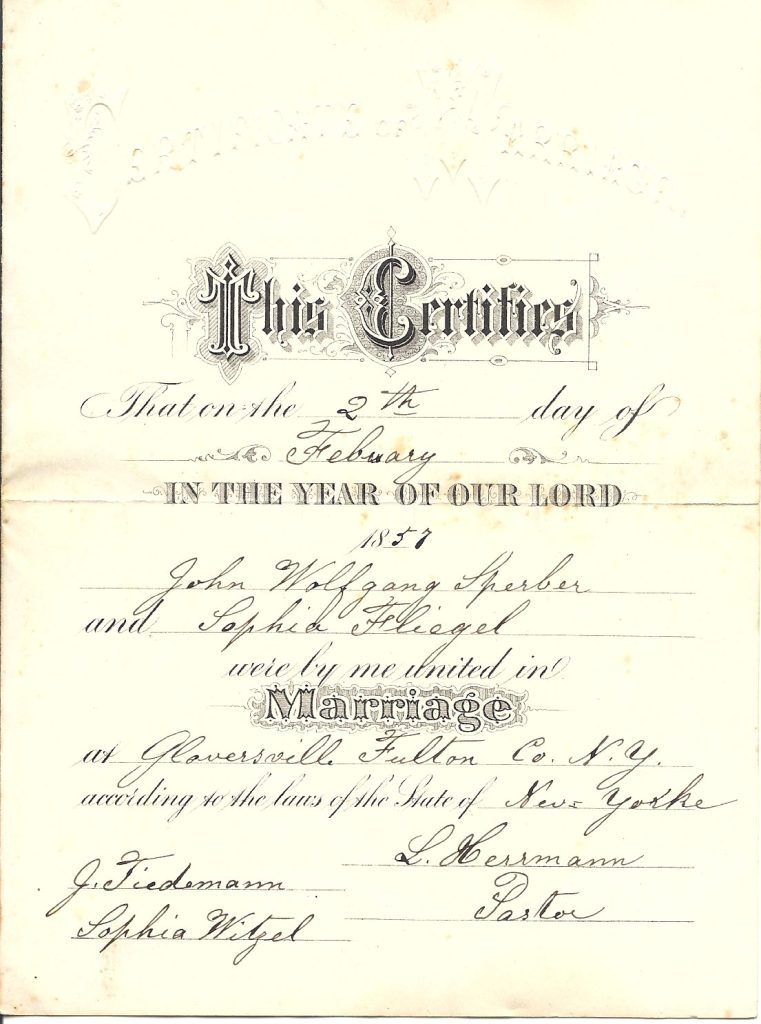
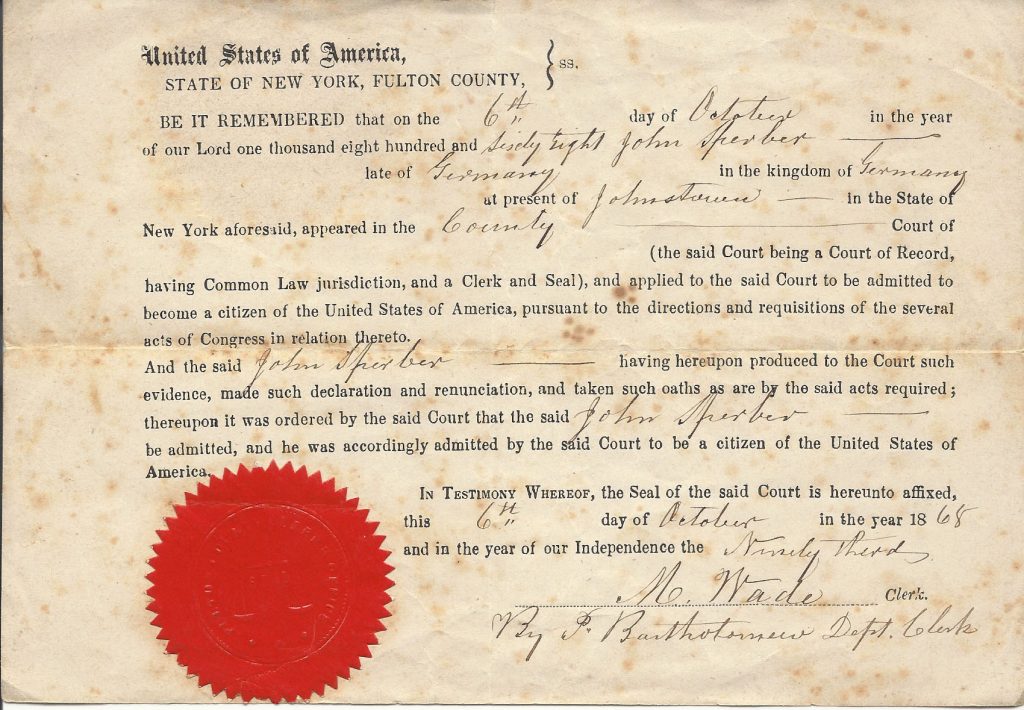
[2] Claire Dinh, Tracing the Evolution of the German Language and German Prepositions through an Interdisciplinary Approach, Senior Thesis Department of German Haverford College April 25, 2016 https://scholarship.tricolib.brynmawr.edu/bitstream/handle/10066/18702/2016DinhC.pdf?sequence=1&isAllowed=y
Sarah Waldmann, The History of the German Language, Babbel, 22 Oct 2020, https://www.babbel.com/en/magazine/history-of-german-language
History of German, Wikipedia, This page was last edited on 29 June 2023, https://en.wikipedia.org/wiki/History_of_German
German language, Wikipedia, This page was last edited on 30 June 2023, https://en.wikipedia.org/wiki/German_language
Salmons, Joseph A History of German: What the Past Reveals about Today’s Language. Oxford: Oxford University Press, 2012
[3] Costas Melas, History of the Germanic Languages, Frameshot of a Youtube Video, 6:19 minutes of part of a 6:53 video, https://youtu.be/yl4xwxNdKgE
[4] Karen Ann, The History of Old German Cursive Alphabet and Typefaces, German Girl in America Blog, 22 Jan 2021, https://germangirlinamerica.com/old-german-cursive-alphabet-and-typefaces/
On the History of Old German Script, the Walden Font Co., page accessed 6 Jan 2023, https://www.waldenfont.com/OntheHistoryofOldGermanScript.asp
Pommern Podcast, Learn to Read Old Script – Introduction, Kurrentschrift, and Capitals, YouTube Video, https://youtu.be/oZ6a6goOTyQ
[5] German language, Wikipedia, This page was last edited on 30 June 2023, https://en.wikipedia.org/wiki/German_language
Kurrent, Wikipedia, This page was last edited on 5 January 2023, https://en.wikipedia.org/wiki/Kurrent
Kenton Library, Deciphering Old German Documents–Tips and Tricks for Easier translation, YouTube Video, https://youtu.be/FgdSQ0Y8ed8
FamilySearch has a number of web links that potentially can be helpful in deciphering German handwriting:
Germany Languages, Family Search, This page was last edited on 5 December 2022, https://www.familysearch.org/en/wiki/Germany_Languages
- These are FamilySearch links to lessons and websites that can assist in learning to read the records of Germany:
- For more information about reading German writing, see Germany Handwriting.
[6] Germanic Genealology, Heritage, Language & Culture, group managed by Stephen C Wendt, Facebook, https://www.facebook.com/groups/germangenealogy.heritage.language.culture
[7] Translate Old German Scripts with Transkribus, Read Co-Op, https://readcoop.eu/transkribus/old-german-scripts/#:~:text=Transkribus%20helps%20you%20to%20convert,the%20help%20of%20artificial%20intelligence.
See also: List of Names in Old German Script A comprehensive list of German given names, written in old script, with possible variations., Family Search
[8] Liraz Postan, Translation: Art or Science?, 8 Jan 2020, Blend, https://www.getblend.com/blog/translation-art-science/
[9] There is a reference to a German based website that produces a Kurrent script based version of a word or series of words that you type into a web form. Similar to an on-line translation service but instead of producing a translation, the form produces a script version of the typed German word.
The website in the following FamilySearch.org citation no longer exists but a version of of the website was found at:
http://www.kurrentschrift.net/index.php?s=schreiben
Barbel Bell, Deciphering German Script 13-24, FamilySearch.org, 18 Jan 2008, page 18, https://www.familysearch.org/en/wiki/Deciphering_German_Script_13-24#/media/File:Script19.jpg
[10] Barbell Bell, Deciphering German Script (Kurrentschrift): A Guide for Genealogists with particular Reference to Documents written from the 1500’s to the early 1900’s, FamilySearch.org, 4 Jun 2008, page 11. https://www.familysearch.org/en/wiki/Deciphering_German_Script_13-24#/media/File:Script13.jpg
[11] Illegitimacy in the United States, FamilySearch, This page was last edited on 17 May 2022 https://www.familysearch.org/en/wiki/Illegitimacy_in_the_United_States
[12] The following New York State and U.S. Federal Census tabulations list Rose Sperber Knopf as being born in 1855 or 1856:
Census Records for Rose Sperber Knopf
| Records Source | Reported Age | Imputed Birth Year |
|---|---|---|
| 1865 N.Y. State Census | 9 | 1856 |
| 1870 U.S. Federal Census | 14 | 1856 |
| 1875 N.Y. State Census | 19 | 1856 |
| 1880 U.S. Federal Census | 25 | 1855 |
| 1892 N.Y. State Census | 36 | 1856 |
| 1905 N.Y. State Census | 49 | 1856 |
| 1910 U.S. Federal Census | 53 | 1857 |
| 1920 U.S. Federal Census | 60 | 1860 |
| 1930 U.S. Federal Census | 73 | 1857 |
| 1940 U.S. Federal Census | 79 | 1861 |
| New York, New York, U.S., Extracted Death Index, 1862-1948 | 80 | 1856 |
Year: 1870; Census Place: Johnstown, Fulton, New York; Roll: M593_938; Page: 183A, Line 35
Year: 1880; Census Place: Brooklyn, Kings, New York; Roll: 854; Page: 493D; Enumeration District: 217, Line 45
Year: 1910; Census Place: Brooklyn Ward 28, Kings, New York; Roll: T624_981; Page: 5b; Enumeration District: 0892; FHL microfilm: 1374994 ,Line 81
Year: 1920; Census Place: Brooklyn Assembly District 20, Kings, New York; Roll: T625_1177; Page: 8A; Enumeration District: 1302, Line 46
Year: 1930; Census Place: Brooklyn, Kings, New York; Page: 6B; Enumeration District: 0402; FHL microfilm: 2341269, Line 73
Year: 1940; Census Place: New York, Kings, New York; Roll: m-t0627-02610; Page: 6A; Enumeration District: 24-2421, Line 6
Census of the state of New York, for 1865. Microfilm. New York State Archives, Albany, New York., Fulton County, Johnstown, Page 387, Line 35
Census of the state of New York, for 1875. Microfilm. New York State Archives, Albany, New York. Fulton County, Johnstown, E.D. 02, Page 428, Line 32
New York State Archives; Albany, New York; State Population Census Schedules, 1905; Election District: A.D. 20 E.D. 26; City: Brooklyn; County: Kings, Page 12, Line 22
1892 New York State Census. New York State Education Department, Office of Cultural Education. New York State Library, Albany, NY., Kings County, Brooklyn Ward 18, E.D. 50, Page 10
Index to New York City Deaths 1862-1948. Indices prepared by the Italian Genealogical Group and the German Genealogy Group, and used with permission of the New York City Department of Records/Municipal Archives.
[13] New York, U.S., Arriving Passenger and Crew Lists (including Castle Garden and Ellis Island, 1820-1957, The National Archives and Records Administration; Washington, D.C.; Ancestry.com. New York, U.S., Arriving Passenger and Crew Lists (including Castle Garden and Ellis Island), 1820-1957 [database on-line]. Lehi, UT, USA: Ancestry.com Operations, Inc., 2010; January 26, 1855 arrival, Ship: Zurich, Lines 3-7.
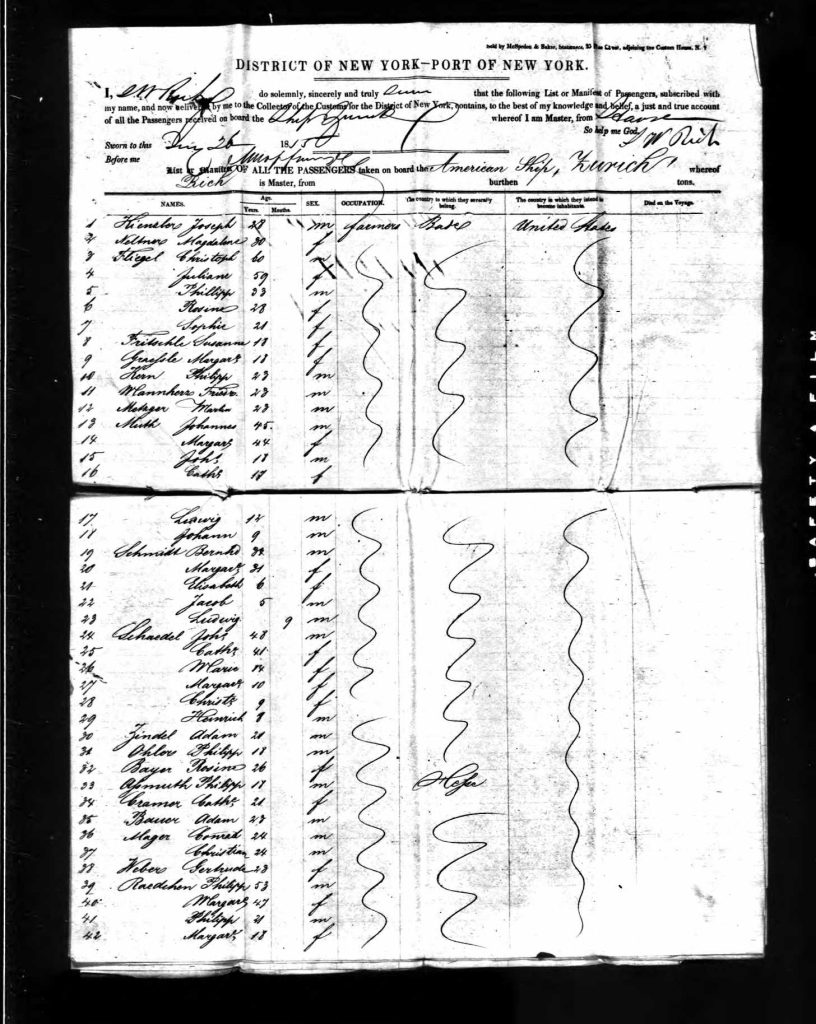
[14] Michael Obladen; Dishonoured: The Fate of Infants Born out of Wedlock. Neonatology 3 October 2022; 119 (5): 652–659. https://doi.org/10.1159/000525306
[15] Illegitimacy in the United States, FamilySearch, This page was last edited on 17 May 2022 https://www.familysearch.org/en/wiki/Illegitimacy_in_the_United_States
See also:
Abigail Trafford, Unwed Motherhood Insights from the Colonial Era, 8 Jan 1991, The Washington Post, https://www.washingtonpost.com/archive/lifestyle/wellness/1991/01/08/unwed-motherhood-insights-from-the-colonial-era/14ff7ff2-d03d-4552-86c5-73b8c15341b0/#
Lisa Lisson, How to Research You Illegitimate Ancestors, 16 Oct 2017, Are you my cousin? Genealology, https://lisalisson.com/how-to-research-your-illegitimate-ancestors/
How to find the father of an illegitimate child, 3 Jul 2023, Who Do You Think You are?, https://www.whodoyouthinkyouaremagazine.com/tutorials/illegitimate-ancestors/
Donna Przecha, “Illegitimate Children and Missing Fathers,” Genealogy.com, accessed July 03, 2018, https://www.genealogy.com/articles/research/52_donna.html
[16] Lee, W. R. “Bastardy and the Socioeconomic Structure of South Germany.” The Journal of Interdisciplinary History, vol. 7, no. 3, 1977, pp. 403–25. JSTOR, https://doi.org/10.2307/202573. Accessed 3 July 2023.
Shorter, Edward. “Illegitimacy, Sexual Revolution, and Social Change in Modern Europe.”The Journal of Interdisciplinary History, vol. 2, no. 2, 1971, pp. 237–72. JSTOR, https://doi.org/10.2307/202844. Accessed 4 July 2023.
Shorter, Edward. “Female Emancipation, Birth Control, and Fertility in European History.”The American Historical Review, vol. 78, no. 3, 1973, pp. 605–40. JSTOR, https://doi.org/10.2307/1847657. Accessed 4 July 2023.



